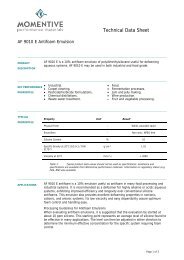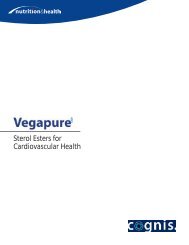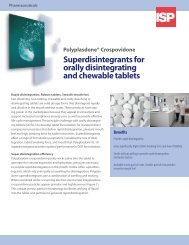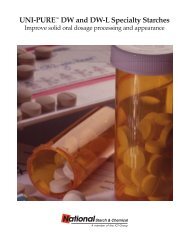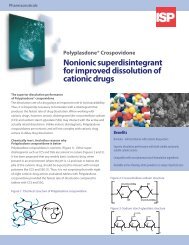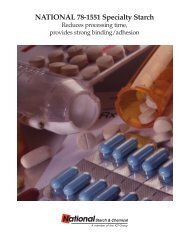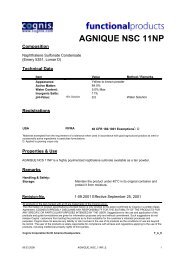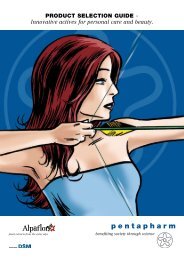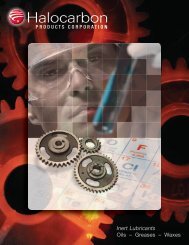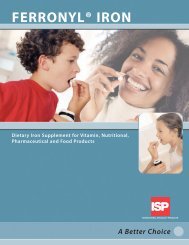ISP Pharma - Pharmasolve Vet Product Applications - Sell ...
ISP Pharma - Pharmasolve Vet Product Applications - Sell ...
ISP Pharma - Pharmasolve Vet Product Applications - Sell ...
You also want an ePaper? Increase the reach of your titles
YUMPU automatically turns print PDFs into web optimized ePapers that Google loves.
<strong>Pharma</strong>ceuticals<br />
PRODUCT<br />
INTER<br />
<strong>Pharma</strong>solve® NMP<br />
Drug solubilizer for veterinary products<br />
<strong>Product</strong> overview<br />
A water-miscible polar aprotic solvent with high interfacial activity,<br />
<strong>Pharma</strong>solve N-Methyl-2-Pyrrolidone (NMP) is used as a drug solubilizer<br />
and penetration enhancer in parenteral and topical dosage forms.<br />
<strong>Pharma</strong>solve NMP has a history of use with many different drug<br />
actives and routes of administration. <strong>ISP</strong> offers a high quality, cGMP<br />
grade of NMP specifically for use in veterinary products. <strong>ISP</strong> grades of<br />
<strong>Pharma</strong>solve NMP conform to the monographs for n-Methylpyrrolidone<br />
and n-Methyl-2-Pyrrolidone in Ph. Eur and JPE, respectively.<br />
Drug solubility in parenteral applications<br />
For poorly soluble drugs administered parenterally, the number of<br />
suitable vehicles to dissolve or disperse the formulation is limited. One<br />
option is to use <strong>Pharma</strong>solve NMP. Enhanced solubility is seen with<br />
select drugs when <strong>Pharma</strong>solve NMP is included in the formulation<br />
because of the polar nature of the molecule.<br />
In a review of the literature, NMP has appeared in veterinary applications<br />
as a solubilizing agent for several antibiotic and sulfa drugs. The literature<br />
describes injectable compositions with high concentrations of florfenicol,<br />
an antibiotic with low aqueous solubility containing 10 to 65% w/w NMP<br />
(1). The compositions have good physical and chemical stability with<br />
desirable viscosity for good syringeability over a wide temperature range.<br />
In another example, oxytetracylcine antibiotic compositions with 25<br />
to 50% w/w NMP and 1 to 10% w/w Povidone reduce swelling or pain<br />
typically associated with tetracycline type compounds (2). Long-acting,<br />
injectable parasitical compositions with ivermectin and 40-65% w/v<br />
NMP and Povidone K-17 have also been developed (3). Sulfadimethoxine<br />
and sulfamethazine are used as therapeutic agents in long lasting<br />
injectables for veterinary applications. In the formulations, NMP is present<br />
as a cosolvent in concentrations from 40 to 65% w/v in water (4). The<br />
compositions may also include Povidone.<br />
Benefits<br />
Enhanced solubility of select drugs<br />
Enhanced permeability of drugs through the skin<br />
Increased bioavailability of select drugs<br />
Inherently stable material<br />
Resistant to hydrolysis<br />
Proven in antibiotics and sulfa drugs, steroids,<br />
and anti-inflammatory compounds<br />
Penetration enhancement in<br />
topical applications<br />
Several published studies discuss the use of<br />
NMP as a strategy to enhance the permeability<br />
of drugs through the skin. In one study, the<br />
occluded vasoconstrictor assay was used to<br />
assess the effect of penetration enhancers on<br />
the topical bioavailability of a representative<br />
steroid, betamethasone 17-benzoate (5). Of all<br />
the penetration enhancers investigated in the<br />
study, the researchers concluded that only NMP<br />
significantly increased the bioavailability of betamethasone<br />
17-benzoate. In a separate study,<br />
the addition of 2% NMP in different ointment<br />
formulations of mefenamic acid increased the<br />
penetration of the drug by 1.5 times (6).<br />
Several topical formulations have also been<br />
developed in which NMP solubilizes griseofulvin,<br />
an antibiotic used to treat fungal infections
<strong>Pharma</strong>ceuticals<br />
of the skin and nails in animals (7). In addition, the literature<br />
cites the use of theophylline as an active ingredient to provide<br />
useful topical anti-inflammatory activity in animals (8). This<br />
work describes novel topical compositions comprising 0.1 to<br />
1% theophylline and 5 to 99% NMP.<br />
Physical and chemical properties<br />
Stability:<br />
<strong>Pharma</strong>solve NMP is a stable<br />
material. It is exceedingly resistant to<br />
hydrolysis, except at pH below 1.5 or<br />
above 11.0. Table 1 describes the typical<br />
physical and chemical properties.<br />
H 2 C<br />
H 2 C CH 2<br />
CH 3<br />
Table 1. Typical Properties:<br />
Appearance<br />
Clear, colorless liquid<br />
Purity >99.7%<br />
Viscosity (cP at 25ºC)<br />
1.7 as is<br />
Flash Point (ºC)<br />
93 (194ºF)<br />
Vapor Pressure (mm Hg @ 20ºC) 0.27<br />
Boiling Point (ºC)<br />
202 (395.6ºF)<br />
C=O<br />
Viscosity:<br />
The viscosity of anhydrous <strong>Pharma</strong>solve NMP decreases with<br />
temperature (Figure 1). The viscosity of an aqueous mixture of<br />
water with <strong>Pharma</strong>solve NMP increases until about 30% water<br />
and decreases with continued addition of water (Figure 2).<br />
N<br />
Effect of humidty:<br />
At high relative humidity, above 80%, weight gain due to<br />
hydration is rapid and continues for an extended time period.<br />
At lower humidity, the absorption of water is slower and peaks<br />
at a composition; there is a gradual loss of weight because of<br />
the evaporation of NMP. Eventually, the rate of absorption of<br />
water gradually decreases and the loss of volatilization of NMP<br />
is more substantial (Figure 3).<br />
Weight change (%)<br />
140<br />
120<br />
100<br />
80<br />
60<br />
40<br />
20<br />
0<br />
-10<br />
Figure 3<br />
Effect of humidity on rate<br />
of weight change of NMP<br />
87% RH<br />
85% RH<br />
52% RH<br />
31% RH<br />
10 20 30 40<br />
Time (days)<br />
Note: Static tests conducted in desiccators over appropriate<br />
saturated salt solutions: calcium chloride (31% RH), sodium acid<br />
sulfate (52%), magnesium acetate (65% RH), sodium carbonate<br />
(87%) RH. Two dishes were employed for (1) determination of<br />
weight change and (2) periodic water<br />
Absolute viscosity (cP)<br />
3<br />
2<br />
1<br />
0.5<br />
Figure 1<br />
Effect of temperature<br />
on viscosity of NMP<br />
10 50 100 150 200<br />
Temperature (ºC)<br />
Viscosity of mixture (cP, 25ºC)<br />
5<br />
4<br />
3<br />
2<br />
1<br />
0<br />
Figure 2<br />
Viscosity of mixtures<br />
of water with NMP<br />
10 20 30 40 50 60 70 80 90 100<br />
Water (wt% in mixture)<br />
References:<br />
1. Schering Corporation, “<strong>Pharma</strong>ceutical compositions of florfenicol,”<br />
US patent 5,082,862, January 1992.<br />
2. Bimeda Research and Development, Ltd, “Method of reducing the<br />
swelling or pain associated with antibiotics compositions,” US patent 4,772,460,<br />
September 1988.<br />
3. Biogenesis S.A., “Long acting injectable parasiticidal composition and the process<br />
for its preparation”. US patent 6,054,140, April 2000.<br />
4. Pfizer, Inc., “Long acting sulfonamide injectable compositions,” Eur patent<br />
application EP19800302190, Filed June 1980.<br />
5. Barry, B.W., D. Southwell and R. Woodford, “Optimization of bioavailability of<br />
topical steroids: Penetration enhancers under occlusion,” J. of Investigative<br />
Dermatology, 82:49-52, 1984.<br />
6. Naito, S., S. Nakamori, M. Awataguchi, T. Nakajima, and H. Tominaga,<br />
“Observations on and pharmacokinetic discussion of percutaneous absorption of<br />
mefenamic acid,” Int. J. <strong>Pharma</strong>ceutics, 24: 127-147, 1985.<br />
7. Stoughton, R.B., “Composition and method for topical administration of<br />
griseofulvin,” US patent 3,932,653, January 1976.<br />
8. Schorer, R.A., “Topical anti-inflammatory composition and method of use,”<br />
US patent 3,957,994, May 1976.<br />
To find an <strong>ISP</strong> sales office in your country visit: ispcorp.com<br />
EMAIL: pharmaceuticalinfo@ispcorp.com<br />
ARGENTINA Tel: +54 11 4314-8971 GERMANY Tel: +49 (0) 2236 9649-260<br />
BRAZIL Tel: +55 11 3649-0455 INDIA Tel: +9122 2837-0472<br />
CHINA Tel: +8621 6249-3900 MEXICO Tel: +52 55 5276-6110<br />
<strong>Pharma</strong>solve® is a trademark of the <strong>ISP</strong> Group.<br />
UK Tel: +44 (0) 207 519-5054<br />
USA Tel: +1 973-628-4000<br />
The information contained in this document and the various products described are intended for use only by persons having technical skill and at their own discretion and risk after they have<br />
performed necessary technical investigations, tests and evaluations of the products and their uses. While the information herein is believed to be reliable, we do not guarantee its accuracy<br />
and a purchaser must make its own determination of a product’s suitability for purchaser’s use, for the protection of the environment, and for the health and safety of its employees and the<br />
purchasers of its products. Neither <strong>ISP</strong> nor its affiliates shall be responsible for the use of this information, or of any product, method or apparatus described in this document. Nothing herein<br />
waives any of <strong>ISP</strong>’s or its affiliates’ conditions of sale, and WE MAKE NO WARRANTY, EXPRESS OR IMPLIED, OF MERCHANTABILITY OR FITNESS OF ANY PRODUCT FOR A PARTICULAR USE<br />
OR PURPOSE. We also make no warranty against infringement of any patents by reason of purchaser’s use of any information, product, method or apparatus described in this document.<br />
IN<br />
ispcorp.com



